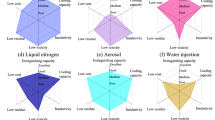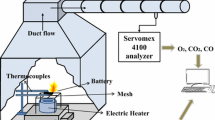Abstract
The jet fire caused by thermal runaway in lithium-ion batteries can be regarded as typical hazard, severely threatening human life. To study the inhibitory effect of water mist containing additives on thermal runaway-induced jet fire in lithium-ion batteries, an experimental test device employing water mist to suppress fire in lithium-ion batteries was developed. In this work, water mist containing additives was used to extinguish the thermal runaway-induced jet fire. The optimal composition of the additive-containing water mist was as follows by mass: 0.22% FC4430, 0.2% TEOA, 0.32% urea, and 2% KCl. The four-factor and three-level orthogonal methods were employed to explore the inhibitory effect of additive-containing water mist on thermal runaway-induced jet fire in lithium-ion batteries. The optimal composition of mist as determined from these methods was: 0.17% FC-4430, 0.2% TEOA, 0.32% urea, and 2.5% KCl. The results show that the synergistic effects of the physical and chemical additives can significantly improve the ability of water mist to suppress jet fires in lithium-ion batteries. In addition, the additive-containing water mist could be used as a new type of extinguishing agent.














Similar content being viewed by others
References
Mao BB, Huang PF, Chen HD, Wang QS, Sun JH. Self-heating reaction and thermal runaway criticality of the lithium ion battery. Int J Heat Mass Transf. 2020;149:119178.
Cui C. The research and application of lithium ion power battery safety. Beijing: Tsinghua University; 2014.
Zhang QS, Cheng XJ, Bai W. Experimental study on suppressing thermal control of lithium-ion batteries with additive water mist. Sci Technol Eng. 2018;18(2):372–6.
Liu J, Wang ZR, Gong JH, Luo QK, Wang H, Guo LS. Experimental study of thermal runaway process of 18650 lithium ion battery. Materials. 2017;10(230):1–12.
Gao TF, Wang ZR, Guo LS, Chen SC. Hazardous characteristics of charge and discharge of lithium-ion batteries under adiabatic environment and hot environment. Int J Heat Mass Transf. 2019;141:419–31.
Yang Y, Wang ZR, Jiang JC, Bian H, Mao N, Guo LS. Effects of different charging and discharging modes on thermal behavior of lithium ion batteries. Fire Mater. 2020;44:90–9.
Chen SC, Wang ZR, Wang JH, Tong X, Yan W. Lower explosion limit of the vented gases from Li-ion batteries thermal runaway in high temperature condition. J Loss Prev Process Ind. 2019;63:1–7.
Wang QS, Ping P, Zhao XJ, Chu GQ, Sun JH, Chen CH. Thermal runaway caused fire and explosion of lithium ion battery. J Power Sources. 2012;208:210–24.
Summer SM. Flammability assessment of lithium-ion and lithium-ion polymer battery cells designed for aircraft power usage: US Department of Transportation, Federal Aviation Administration; 2010.
Li Y, Zhang SY, Liu X, Wang JQ. Study on fire risk of lithium ion battery. China Saf Sci J. 2012;22(11):36–41.
Ping P, Kong DP, Zhang JQ, Wen RX, Jennifer W. Characterization of behaviour and hazards of fire and deflagration for high energy Li-ion cells by over-heating. J Power Sources. 2018;398:55–66.
Chen MY, Zhou DC, Chen X, Zhang WX, Liu JH, Yuen R, Wang J. Investigation on the thermal hazards of 18650 lithium ion batteries by fire calorimeter. J Therm Anal Calorim. 2015;122:755–63.
Jhu CY, Wang YW, Shu CM, Chang JC, Wu HC. Thermal explosion hazards on 18650 lithium ion batteries with a VSP2 adiabatic calorimeter. J Hazard Mater. 2011;192:99–107.
Kong LX, Li C, Jiang JC, Pecht MG. Li-ion battery fire hazards and safety strategies. Energies. 2018;11:2191.
Blum A, Long RT. Full-scale fire tests of electric drive vehicle batteries. SAE Int J Passeng Cars-Mech Syst. 2015;8:565–72.
Russo P, Bari CD, Mazzaro M, Rosa AD, Morriello I. Effective fire extinguishing systems for lithium-ion battery. Chem Eng Trans. 2018;67:727–32.
Shen R, Jiao Z, Parker T, et al. Recent application of computational fluid dynamics (CFD) in process safety and loss prevention: a review. J Loss Prev Process Ind. 2020;67:104252.
Wen XP, Wang MM, Su TF, Zhang SM, Pan RK, Ji WT. Suppression effects of ultrafine water mist on hydrogen/methane mixture explosion in an obstructed chamber. Int J Hydrog Energy. 2019;44(60):32332–42.
Jones A, Nolan PF. Discussions on the use of fine water sprays or mists for fire suppression. J Loss Prev Process Ind. 1995;8(1):17–22.
Cao XY, Bi MS, Ren JJ, Chen B. Experimental research on explosion suppression affected by ultrafine water mist containing different additives. J Hazard Mater. 2019;368:613–20.
Yoshida A, Okawa T, Ebina W, Natio H. Experimental and numerical investigation of flame speed retardation by water mist. Combust Flame. 2015;162:1772–7.
Willauer HD, Ananth R, Farley JP, Williams FW. Mitigation of TNT and Destex explosion effects using water mist. J Hazard Mater. 2009;165(3):1068–73.
Xu HL, Wang XS, Gu R, Zhang HP. Experimental study on characteristics of methane–coal dust mixture explosion and its mitigation by ultra-fine water mist. J Eng Gas Turbines Power. 2011;134(6):061401–6.
Luo WT, Zhu SB, Gong JH, Zhou Z. Research and development of fire extinguishing technology for power lithium batteries. Proc Eng. 2018;211:531–7.
Liu T, Liu YP, Wang XS, Kong XX, Li CC. Cooling control of thermally-induced thermal runaway in 18650 lithium ion battery with water mist. Energy Convers Manag. 2019;199:199–209.
Zhu MX, Zhu SB, Gong JH, Zhou Z. Experimental study on fire and explosion characteristics of power lithium batteries with surfactant water mist. Proc Eng. 2018;211:1083–90.
Zhang QS, Cao WJ, Bai W. Experimental study on inhibition effect of water mist on thermal runaway of lithium ion batteries. Fire Saf Sci. 2017;26(04):239–43.
Yu MG, An A, Zhao WL. Additive effectiveness of water mist suppression gas explosion experimental study. J Saf Environ. 2011;11(4):149–53.
Huang PF. Study on fire hazard and critical conditions of thermal runaway of lithium-ion batteries. Hefei: University of Science and Technology of China; 2018.
Babushok VI, Tsang W, Linteris GT, Reinelt D. Chemical limits to flame inhibition. Combust Flame. 1998;115:551–60.
Acknowledgements
The authors are grateful for the support provided by the National Natural Science Foundation of China under Grant No. 51874184, Key R&D programs (Social Development) in Jiangsu Province under Grant No. BE2016771, Key Natural Science Foundation in Jiangsu Province under Grant No. 18KJA620003, Jiangsu Project Plan for Outstanding Talents Team in Six Research Fields (TD-XNYQC-002), and Jiangsu Students’ Platform for Innovation and Entrepreneurship Training Program (201910291206T).
Author information
Authors and Affiliations
Corresponding author
Additional information
Publisher's Note
Springer Nature remains neutral with regard to jurisdictional claims in published maps and institutional affiliations.
Rights and permissions
About this article
Cite this article
Zhou, Y., Wang, Z., Gao, H. et al. Inhibitory effect of water mist containing composite additives on thermally induced jet fire in lithium-ion batteries. J Therm Anal Calorim 147, 2171–2185 (2022). https://doi.org/10.1007/s10973-021-10673-x
Received:
Accepted:
Published:
Issue Date:
DOI: https://doi.org/10.1007/s10973-021-10673-x




